January 18, 2014
by Robin Parker -
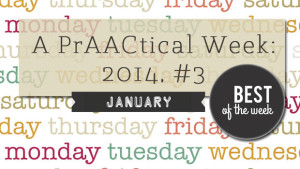
It’s been an awesome PrAACtical Week. Take a look: Sunday: PrAACtical Communication and a Business Monday: PrAACtical Communication Opportunities in SLP Sessions Tuesday: Does AAC Really Work with Infants and Toddlers? Wednesday: Watch It Wednesday – Creating and Using Routines to Promote Interaction Thursday: Throwback Thursday – Visual Schedule Round-Up Friday: A PrAACtical Note of Appreciation (Don’t miss the downloads!)
Filed under: PrAACtical Thinking
Tagged With: resources
January 17, 2014
by Carole Zangari -
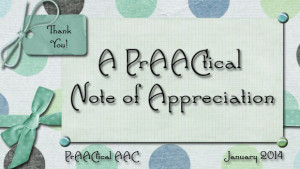
We usually don’t make a fuss over blog birthdays or anniversaries, but this milestone seemed like something worth celebrating. Yesterday, you helped us hit a milestone: Our prAACtical pages have been viewed well over 500,000 times. It’s fun to think of people reading our posts, but this is bigger than us. The ‘AAC message’ is being heard and the AAC community is growing. In every continent, there are SLPs, educators, parents, paraprofessionals, and organization leaders who are giving voice to people who struggle to express themselves. Today, we celebrate YOU! Thanks for the work you do, and for being part of a community that believes everyone has both the right and the ability to communicate. We so enjoy connecting with you and hearing about your prAACtical experiences. Please enjoy these downloadable resources that we’ve developed and shared over the past two years. Forms: Need to flesh out your resources for... [Read More...]
Filed under: PrAACtical Thinking
Tagged With: celebration
January 16, 2014
by Robin Parker -
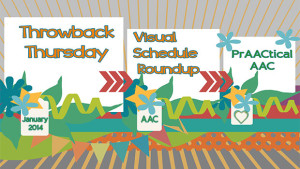
As times goes on in the academic year, we often think that everyone knows their schedules. But remember, knowing and seeing are two completely different things. For this Throwback Thursday, we wanted to go over visual schedules of all types to remind ourselves not to back off with schedules (all types) even if it seems everyone is transitioning well and knows their schedules. We wouldn’t want anyone to take away our day planner…. even when we knew our schedule. What’s the Connection- Core Words & Schedules Visual Schedules 411 Get Organized for the New Year: 5 Visual Schedule Apps Schedule Changes A Myth About Visual Schedules A PrAACtical Myth Lives On.. Again Visual Schedule Myths Live On and On… Power of the Visual Planner Schedules and Choices Riddle Me This AAC at Home: Visual Schedules and Supports Building Complex Schedules Ideas for Teaching the Use of Schedules PrAACtical Mini-Schedules Video... [Read More...]
Filed under: PrAACtical Thinking
Tagged With: visual schedules
January 15, 2014
by Robin Parker -
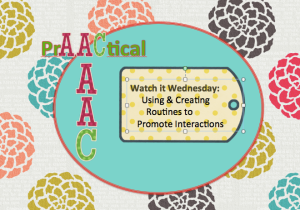
Watch some ways to use classroom routines to build in opportunities for interaction. http://youtu.be/Vl7q_cxjLSg
Filed under: PrAACtical Thinking
Tagged With: Routines, visual supports
January 14, 2014
by Carole Zangari -
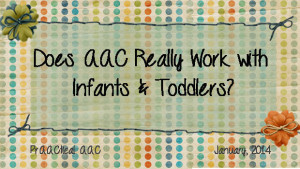
We are occasionally asked how old children have to be before you can begin teaching AAC. Our answer: There is no set minimum age. Nor is there any research evidence that one has to use an oral-language only approach for a set period of time before beginning AAC. Today, we’re delighted to be able to share an article on this topic with you. This article describes a research review in which Branson and Demchak identified a dozen research studies looking specifically at the use of various AAC tools and strategies with infants and toddlers. Data from 190 children up to 36 months of age were examined. Of the 12 studies reviewed, 7 met criteria for having conclusive findings. In 97% of all cases, the children’s communication skills improved. Looking only at the 7 most rigorous studies is even more encouraging: All 135 babies/toddlers demonstrated improved communication skills following AAC intervention.... [Read More...]
Filed under: PrAACtical Thinking
Tagged With: infants, research, toddlers, young children
January 11, 2014
by Carole Zangari -
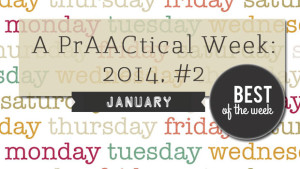
It’s been a wonderfully prAACtical week. Take a look! Sunday: PrAACtically Eating Together Monday: Strategy of the Month: Building a PrAACtice Routine Tuesday: Teach Me Tuesday: Avaz App Wednesday: Watch It Wednesday: Pain in Children with Developmental Disabilities Thursday: PrAACtical Peek: Decorating Cookies Friday: 31 AAC Posts You May Have Missed, December 2014
Filed under: PrAACtical Thinking
January 10, 2014
by Robin Parker -

STRATEGY OF THE MONTH Supporting Pre-Intentional Communicators Breaking Through with Pre-Intentional & Beginning Communicators of ALL Ages Helping Pre-Intentional Communicators to Cross the Intentionality Bridge More Ideas for Supporting Pre-Intentional Communicators PRAACTICAL THINKING PrAActical Nominations: The 2013 Edublog Awards I was Thinking About Buying an AAC App- Now What? 5 Ways to Encourage AAC Learners 30 P0sts You May Have Missed in November How Much Time Do SLP’s In Healthcare Settings Spend on AAC Services to Children AAC Goes to the Eddies Does AAC Benefit Children with Profound and Multiple Disabilities Throwback Thursday: Talk About Me 2 3 Responses to Programs that Make Kids ‘Prove Worthiness’ Prior ro Providing Access to AAC AAC Vocabulary Lists Throwback Thursday- Past Posts About Pre-Intentional and Beginning Communicators Power Words from PrAACtical Friends A PrAACtical Christmas Carol 8 Ways to Have an AAC Holiday Season A PrAACtical Christmas AACtual Therapy with Shareka Bentham- Started from... [Read More...]
Filed under: PrAACtical Thinking
Tagged With: Intentional Communicators, Pre-Intentional Communicators, resources
January 9, 2014
by Carole Zangari -
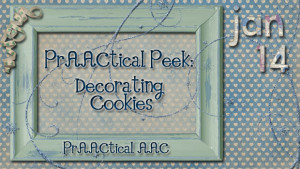
Welcome to PrAACtical Peek, an occasional series which features photos of therapy materials we use. This one is interactive, so have fun exploring the hot spots. Also, we’d love to have YOU get in on the fun. Send us a photo of some of your AAC materials for a future PrAACtical Peek post.
Filed under: PrAACtical Thinking
Tagged With: peek, therapy materials, visual supports
January 8, 2014
by Carole Zangari -
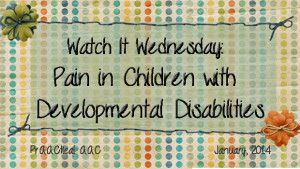
Frustration. Fear. Helplessness. Being with a child in pain is an awful experience no matter what the circumstances. When a child has communication difficulties, the problems are magnified. In this video, we go to the Canadian Association of Paediatric Health Centres for an informative discussion about pain in children with developmental disabilities. Knowing what to look for is a first step in helping reduce pain and increase the coping skills of children with AAC needs. Direct Link to Video: https://www.youtube.com/watch?v=l-CzjHl1aqo
Filed under: PrAACtical Thinking
Tagged With: Medical, pain
January 7, 2014
by Robin Parker -
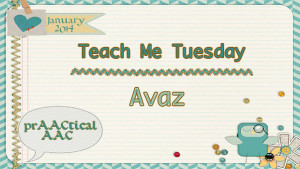
This week in Teach Me Tuesday we’re learning more about Avaz, a comprehensive AAC app. Here are the learning resources we’ll be using. Help Resources Take a Tour Videos Video If you know of other applicable resources, please add them in a comment below. See you next time!
Filed under: PrAACtical Thinking
Tagged With: AAC app, Avaz, Teach Me Tuesday









